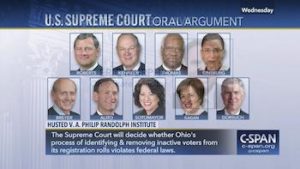
*On this date in 2018, Husted v. A. Philip Randolph Institute was decided. This case was before the United States Supreme Court regarding Ohio's voter registration laws.
Ohio law provides a process to remove an inactive voter from its list of registered voters. After a two-year break from certain voting activities specified by Ohio law (i.e., filing a change of address, filing a registration to vote, casting an absentee ballot, casting a provisional ballot, or voting on election day), the State sends these inactive voters a confirmation notice via mail. If the voter does not respond to that notice, re-register, or vote over the next four years, the voter is removed from the list of registered voters.
A similar approach is used in eighteen other states to trim voter registration lists; however, Ohio's approach relies more heavily on the two-year non-voting break to trigger the process than most other states. Voter suppression can come in many forms, and this case revealed it through the punishment of inconsistent individual voting. In 2016, an estimated 144,000 people were removed from Ohio's voter registration list in the three largest counties in the state, containing the cities of Cleveland, Columbus, and Cincinnati.
The case originated from Larry Harmon, a state resident who had previously voted in the 2008 elections but did not vote in either the 2012 main election or the 2010 and 2014 mid-term elections. Desiring to vote on an issue in 2015, Harmon found that his name had been struck from the voter lists, following Ohio's process, but he claims he never received the postal notice. The A. Philip Randolph Institute, labor, and civil rights group originally filed this lawsuit for Mr. Harmon against Ohio’s Secretary of State, Jon A. Husted, alleging that this process violated the National Voter Registration Act of 1993, which bars states from removing someone from the voter registration list for not voting and sets out a process for states to remove voters who have moved away.
The state prevailed in federal district court. The United States Court of Appeals for the Sixth Circuit reversed. It concluded that although federal law allows Ohio to remove voters who did not respond to the confirmation notice or vote in two elections, the state’s process uses the failure to vote as the basis for initiating removal, which is not authorized by federal law.
At issue was whether federal law, 52 U.S.C. § 20507, permits Ohio's list-maintenance process. This uses a registered voter's inactivity to send a confirmation notice to that voter under the National Voter Registration Act of 1993 and the Help America Vote Act of 2002. If the mail is not returned, the voter is stricken from the rolls, a practice called voter caging. The Court ruled in a 5–4 decision that Ohio's law did not violate federal laws.